What is the single best indicator of the American Dream? Many would point to household income growth. The Census Bureau has now published some selected annual household income data in a new report: Income and Poverty in the United States: 2014. Last year the median (middle) household income was $53,657 — a 0.13% year-over-year increase that shrinks to -1.48% when adjusted for inflation. Let's put the new release into a larger historical context.
Our study of the Census Bureau's historical data shows a 651% growth in median household incomes from 1967 through 2014. Sounds impressive, but if you adjust for inflation using the Census Bureau's method, that nominal 651% total growth shrinks to about 21%.
But if we dig a bit deeper into the method of inflation adjustment, the American Dream looks more like an illusion, as in "money illusion".
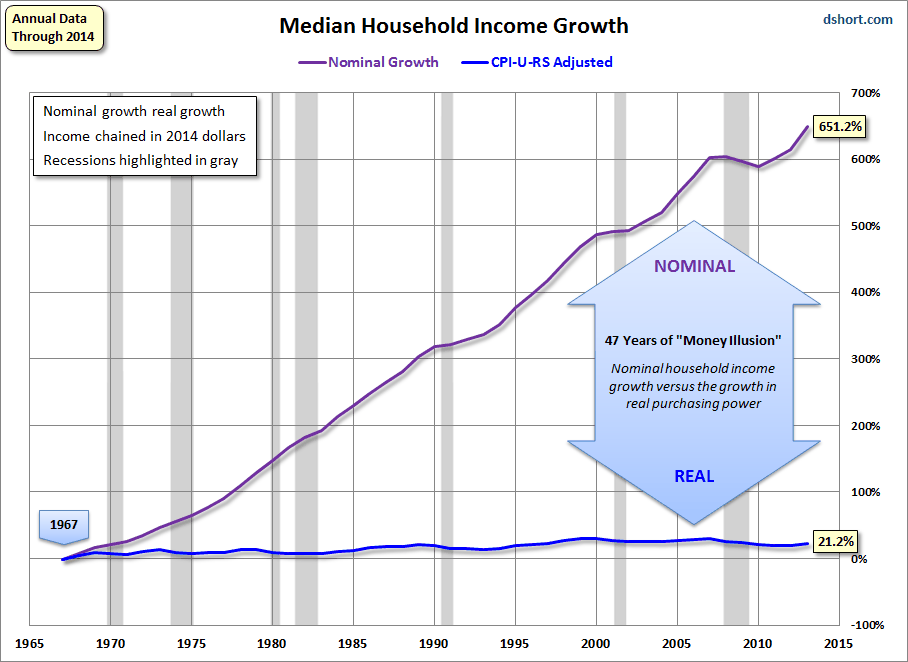
Our primary focus on 21st Century monthly median household income was based on the excellent monthly data available from Sentier Research. See Median Household Incomes: Monthly Update. The Sentier Research findings are based on Census Bureau (CB) data and adjusted for inflation using the Bureau of Labor Statistics (BLS) Consumer Price Index for Urban Consumers (CPI-U), which most people, including the BLS, commonly abbreviate as the "CPI". However, the CB's own annual data series for household income, which reaches back to 1967, uses a different index to "deflate" the nominal income data. The CB researchers adjust using the little-known CPI-U-RS (RS stands for "research series") as the deflator for their annual data.
The BLS website has slender information about this index. A site search turns up this page, which contains a link to a PDF file with the index from 1977 through 2014.
Obviously the CB has a version of the annual CPI-U-RS back to 1967, the starting year for their household income series. We have not found the pre-1978 annual CPI-U-RS data at either the CB or BLS website. However, we can constuct this index from the CB's latest annual data from 1967-2014 in Table H-5 linkable from their Historical Household Income Tables.
The Deflator Difference
A price index, such as the CPI or the BEA's PCE price index, provides the data we need to "deflate" nominal dollar values to their real purchasing power over time. And even in stable economies, over long periods of time, the "money illusion" of nominal values can be substantial, as the chart above painfully illustrates.
As we mentioned earlier, Sentier Research uses the more familiar CPI as the deflator for computing their real household income data series. Does the deflator choice make a significant difference?
The answer is: It depends on your timeframe. If we look at a comparison of nominal and real household income growth since 1967, the difference between the two deflators is stunning.

But, as the next chart shows, the gap between the two lines in the chart above is actually the result of differences between the two deflators in the earlier years of the 47-year period. Since the late 1990s, the two have been nearly identical. The reason is that the CPI-U-RS was developed with the goal of revising the earlier years of the CPI-U to incorporate most of the improvements made to the index to increase its accuracy. For a better understanding of revisions, see the BLS article Addressing misconceptions about the Consumer Price Index (PFD format).
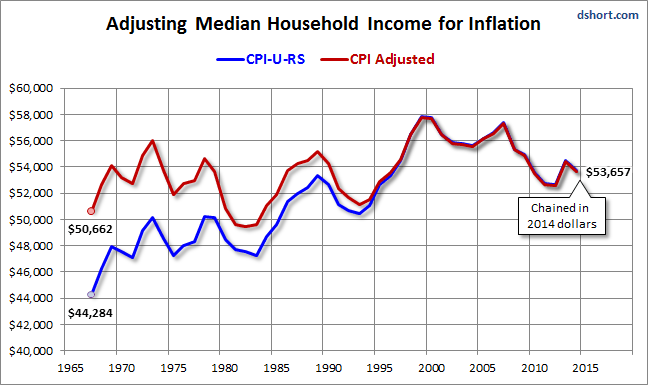
Here is a chart that shows the annual differences between the two, which are predominantly before 2000.
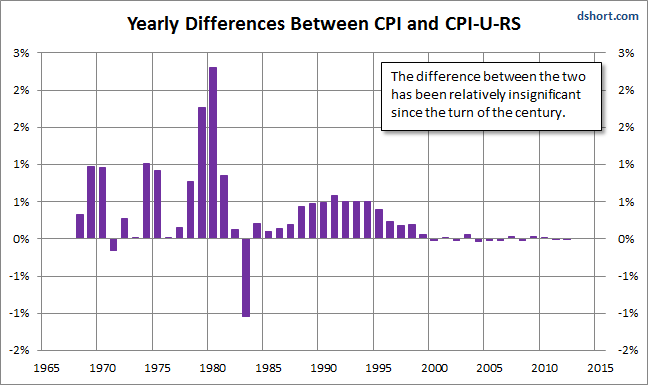
What About Other Deflators?
Another important price index for economic analysis is the BEA's PCE price index. It is the preferred measure of inflation for the Federal Reserve, and we analyze it every month shortly after the BEA's Personal Income and Outlays report is released:
The next chart shows three versions of real household income growth. We've added version deflated with PCE price index alongside the other two real series we've been studying. We've also included markers to facilitate our understanding of the annual changes through time. The PCE-deflated version is the most optimistic of the three. The CPI-adjusted version is by far the most pessimistic.
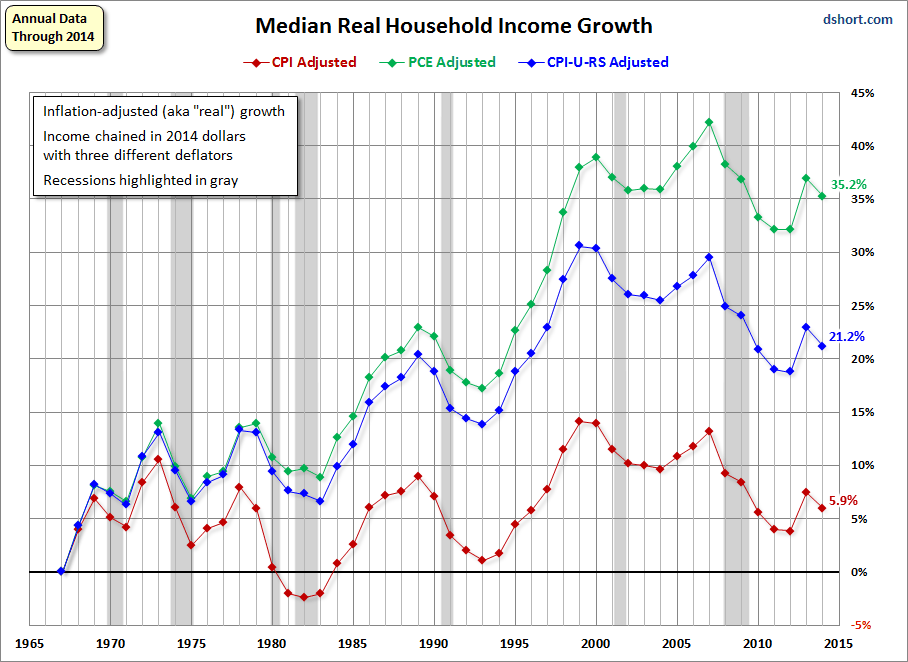
Real Household Income as a Leading Recession Indicator
An interesting feature of the chart above, regardless of which deflator you prefer, is that median incomes began contracting before every recession. On an annual basis, incomes typically bottomed at some point after the recession ended and moved higher. The one conspicuous exception was the second half of the early 1980s double-dip.
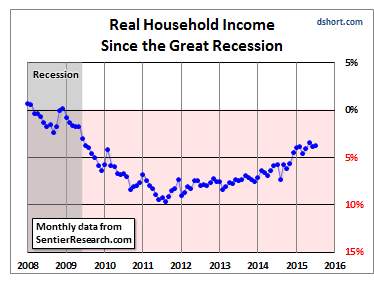
Flash forward to the near present (2014 in our annual data): The median household income appears to be in a slow-motion process of bottoming. With the CPI deflator, the Sentier Research approach, real median income appeared to have troughed in August 2011 and then slowly risen to the most recent monthly data (July 2015).
Anyone who finds this analysis of interest should download the Sentier Research Household Income Trends report (PDF format). The underlying data is available from Sentier Research for a small fee here.
For Further Reading : Here is a checklist of our recent commentaries on household income:
- Median Household Incomes: Monthly Update
- U.S. Household Incomes: A 47-Year Perspective
- U.S. Median Household Incomes by Age Bracket: 1967-2014
Footnote on the Alternate CPI: Experience has taught us that whenever we address the topic of inflation and various price indexes, we get several emails from fans of Shadowstats.com asking why we didn't include the Shadowstats Alternate CPI. So, to avoid those emails, we've created the chart below with one more deflated version of median household incomes. The new one uses the ShadowStats Alternate CPI.
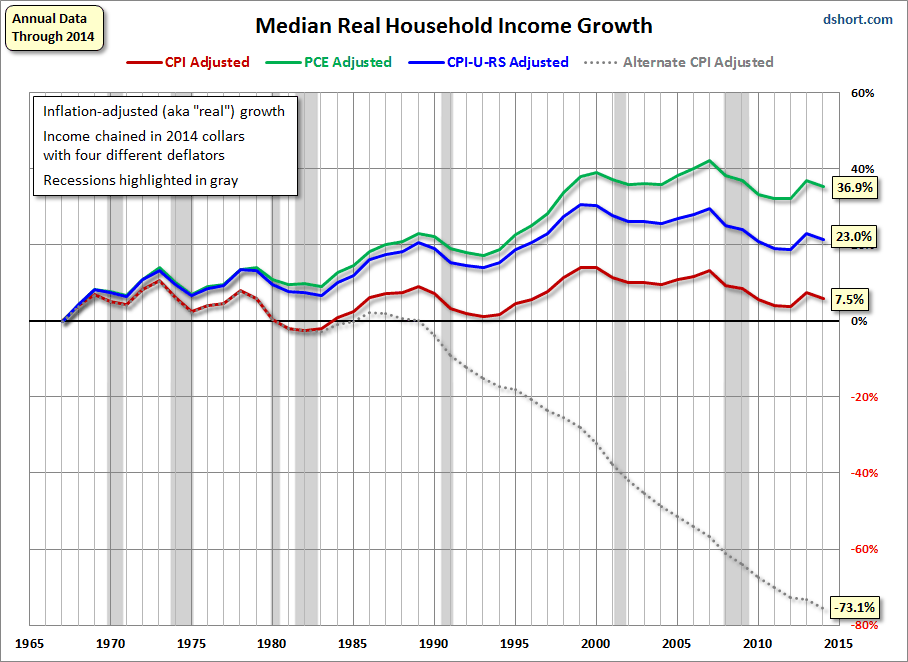
As the chart above suggests, the Alternate CPI is a rather bizarre outlier. What this deflator is telling us translates into something like this: The 1967 median household income of $7,143 chained in 2014 dollars would have had the purchasing power equivalent to around $218,000 today. The "elderly" among us understand that this is sheer nonsense.
